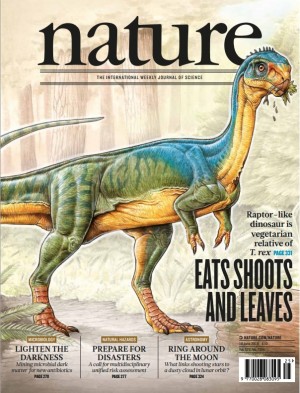“형아들이 결정하면 가는거야~” Signs of democracy seen in typically authoritarian baboon society
네이처,
티라노 닮은 초식 수각류 칠레사우루스 디에고수아레지
네이처 제공
edited by kcontents
케이콘텐츠 편집
이번 주 ‘사이언스’ 표지에는 강렬한 눈빛을 내뿜으며 어딘가를 주시하는 개코원숭이가 등장한다. 다부진 몸짓과 위엄 있는 표정에서 한눈에 무리의 우두머리라는 사실을 알아볼 수 있다.
지금까지 학자들은 개코원숭이처럼 위계질서를 유지하는 동물 집단에서 어떤 방식으로 무리의 의사 결정이 이뤄지는지 제대로 이해하지 못했다. 무리에 속한 각 개체들의 행동을 개별적으로 분석하고 그것을 하나로 모아 분석해야 하는데 그게 쉽지 않기 때문이다.
마가렛 크로풋 데이비스 캘리포니아대(UC데이비스) 인류학과 교수팀은 위치추적장치를 이용해 아프리카 개코원숭이들의 의사결정 방식을 연구한 결과를 ‘사이언스’ 19일자에 게재했다.
연구진은 케냐 음팔라연구소에 있는 개코원숭이 25마리에 위치추적장치를 부착한 뒤 무리가 어떤 방식으로 움직이는지 관찰했다. 그랬더니 지도부격인 특정 원숭이 몇 마리가 움직이는 방향 결정을 주도하고 나머지 원숭이들은 이들의 결정에 따라 움직인다는 사실을 알아냈다.
특히 지도부 원숭이들이 향하는 방향의 각도 차이가 90도 이내였을 때에는 서로 타협해서 방향을 조정하지만 그 차이가 90도 이상일 때는 의견 대립을 보이면서 무리의 이동이 정체되는 모습을 보였다. 무리가 우두머리 한 마리의 독재가 아니라 지도부의 의사결정 과정에 따라 움직인다는 사실을 확인한 것이다.
네이처 제공 이번주 ‘네이처’ 표지는 영화 ‘쥬라기 월드’의 포스터를 보는 것 같다. 두 발로 선 거대한 공룡이 놀란 눈으로 정면을 응시하고 있다. 이 공룡은 2004년 칠레에서 디에고 수아레스라는 7살 꼬마가 발견해 ‘칠레사우루스 디에고수아레지’라는 이름이 붙은 수각류다.
그런데 뭔가 어색하다. 단단한 근육과 티라노사우루스를 빼닮은 외모를 가진 이 공룡은 주둥이에 나뭇잎을 한가득 물고 있다. 겉모습만 보면 피가 뚝뚝 흐르는 고기를 베어 물고 있어야 할 것 같은데, 18일자 네이처에는 이 공룡이 초식공룡이라는 연구 결과가 게재됐다.
수각류는 대부분 이족보행을 하며 티라노사우루스와 벨로키랍토르처럼 육식을 하는 것으로 알려져 있다. 페르난도 노바스 아르헨티나 국립자연과학박물관 박사팀은 칠레사우루스의 화석을 조사한 결과 조류를 닮은 부리와 나뭇잎 모양의 이빨을 갖고 있다는 점을 초식의 증거로 꼽았다.
연구진은 칠레사우루스가 지금으로부터 1억5000만 년 전인 쥐라기 말에 서식했을 것으로 추정하면서 지금까지 생각했던 것보다 훨씬 전에 초식 수각류 공룡이 등장했을 수 있다고 설명했다. 동아사이언스 최영준 기자 jxabbey@donga.com |
Signs of democracy seen in typically authoritarian baboon society

By Virginia Morell When it’s time to travel, wild olive baboons make democratic decisions about where to go, even though they live in hierarchical societies. The discovery is a surprise, researchers report online today in Science, because large, alpha males typically get their way—pushing subordinates aside to get food or mates. But when choosing where to travel, a baboon’s social rank or sex is irrelevant, perhaps because the decision affects the entire group. The scientists teased apart the animals’ decision-making process by trapping and fitting GPS collars on 25 baboons (Papio anubis) in Kenya. The collars recorded each animal’s location every second for 14 days while they moved, ate, played, and just hung out together (as in the photo above). Using these data, the researchers studied the baboons’ movements relative to one another. Their analysis revealed that certain baboons are “initiators”—individuals who typically step away from the others. If another baboon followed, then it was likely others would as well, until the entire troop was on the move. But if no one followed the initiator, the group was more apt to stay put. The team found that the baboons preferred to travel when there were several initiators who all agreed on a particular direction. When they disagreed, the other baboons didn’t come to blows. Instead, they voted with their feet and simply followed the subgroup with the most initiators. The study suggests that even in highly stratified societies, there may be an evolutionary benefit to settling disputes with egalitarian rules rather than fisticuffs. Posted in Evolution, Plants & Animals Animal Cognition http://news.sciencemag.org/evolution/2015/06/signs-democracy-seen-typically-authoritarian-baboon-society |
edited by kcontents
"from past to future"
데일리건설뉴스 construction news
콘페이퍼 conpaper










